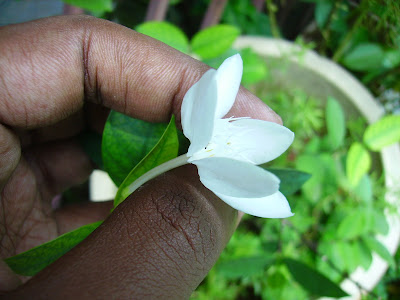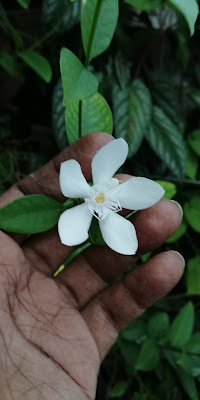INTRODUCTION:
(Wrightia Antidysenterica) commonly known as Coral swirl, Tellicherry bark, Walidda, Artic Snow, Milky Way, Snowflakes, Sampaguita, Winter Cherry Tree, Sweet Indrajao, Pudpitchaya, Hyamaraca.
There is another Wrightia species, known as Wrightia religiosa commonly known as Water Jasmine has a strong scent in comparison with this one which does not have any scent.
(Wrightia Antidysenterica) has a rich history and cultural background surrounding many nations of which it is very much identified for it's traditional medicinal uses. Also very much identified for its Ayurvedic uses as it considered native plant surrounding the India & Sri Lanka regions.
However, this particular Jasmine like plant has been introduced as an ornamental plant all around the tropical region.
This particular plant seemed to have hard dry mature stem and stands upright - somehow it appears to be grow tall in upright growth and rarely branch sideways, hence this plant do not sprout out new shoots from the base rather only span out new branches from the main stem.
The blooms have 5 petaled star shaped feature with a furry like whiskers corona with yellow center, these may not produce any nectar either as none of the butterflies or bees visit them.
LIGHT:
Being a Tropical plant does require good strong indirect bright sunshine, It can tolerate growing in shaded area however it must receive at least few hours of sunshine. It does not do well in heavy shaded area and may not bloom in such conditions. Also the leaves may turn yellow to light green/pale green and also become leggy. Another factor in the lack of sunlight may cause the plant to become stress and can attract pest to heavily attack on them.
Hence do give a thought if your are not having open garden area as this would not so well as indoor plant - even placing them as a balcony potted plant can be challenging if they do not receive adequate light.
SOIL MEDIUM:
Considering one of the most basic thing about planting material - this one doesn't require anything special - just any balanced potting mix will do. They seem to do fine in a medium or big potted plant - however they will do great if they are planted directly into the garden soil as these will require just that to produce those lovely blooms.
However if limitation occurs where you can only grow in pot - then a good balanced potting mix with rich amount of organic material and equal part of well drained soil which will help from root rot.
However if limitation occurs where you can only grow in pot - then a good balanced potting mix with rich amount of organic material and equal part of well drained soil which will help from root rot.
Instance as such as these - they are often planted straight into open garden land where they are not in a pot - hence they appear hardy and able to take the heavy pruning.
WATERING & FEEDING:
It may require a good adequate watering - both morning and evening based on the size of the plant.
You can grow it in a nice medium or large size pot, the plant will behave and grow based on the size of the pot. However I would recommend this to grow freely on ground if you want lushful beautiful constant blooms.
Also this plant is a heavy feeder and do feed adequately during the flowering season.
It may require a good adequate watering - both morning and evening based on the size of the plant.
You can grow it in a nice medium or large size pot, the plant will behave and grow based on the size of the pot. However I would recommend this to grow freely on ground if you want lushful beautiful constant blooms.
Also this plant is a heavy feeder and do feed adequately during the flowering season.
However take note that over-watering can cause them to bud-drop especially during the rainy season, hence a well balance fast draining medium to ensure no root rot occurs.
PRUNING:
One of the most challenging part for this shrub is pruning. They do grow extremely fast and become very unruly if not proper care is not given - especially when it comes to growth factor, this plant focus more on branching more stem and over growth rather than blooms which can be one of the down-side coming from this ever blooming plant.
However with the right pruning method and keeping it trimmed and manageable size - this one can be such a beauty. This plant can become into a full grown tree - hence pruning and keeping focused in making its growth into one main stem can allow it to bloom more gracefully and not creating a wild-like shrub with stem branching everywhere.
One of the most challenging part for this shrub is pruning. They do grow extremely fast and become very unruly if not proper care is not given - especially when it comes to growth factor, this plant focus more on branching more stem and over growth rather than blooms which can be one of the down-side coming from this ever blooming plant.
However with the right pruning method and keeping it trimmed and manageable size - this one can be such a beauty. This plant can become into a full grown tree - hence pruning and keeping focused in making its growth into one main stem can allow it to bloom more gracefully and not creating a wild-like shrub with stem branching everywhere.

PROPAGATION
The best I found is from the matured stem cuttings. They may stay dormant for weeks, then sprouts may appear from the nodes. Sometimes few of the cuttings may not survive - so it is best to have more cuttings planted than just one.
Propagation can be done but stem cutting, stripping off the bottom leaves and poking it into a deep pot with a rich potting soil. Keep it in shade until you notice a new leaves growth.
Another method is to put the cutting into perlite medium (soaked in water) Once taken roots, it should be carefully transplanted into a good potting mix..
Another method is to put the cutting into perlite medium (soaked in water) Once taken roots, it should be carefully transplanted into a good potting mix..

I believe there is another unidentified variety where the petals are slightly rounder and may be a heavy bloomer, also these are slightly more expensive in comparison to the common type. However I may not able to rectify and clearly make any clear identification in their difference as these might just be the same plant as they may appear differently due to strong application of fertilizer being used in cultivation.
(Pictures Below)






















No comments:
Post a Comment